Tide of Mutiny: A Cinematic Chronicle of Maritime Mishap
In the tradition of the realistic fiction genre, this segment presents the British novel as the impetus for relegating human circumstance to the unbridled excesses of nature. The primary way this is explored is through film adaptation; though, other mediums are given attention due in part to their underlying significance. The series of works begins with rhetorical and hymnal attributes merely to underscore the calamity portrayed in the cinematic, or even animated, version of the narrative.
Learn from me, if not by my precepts, at least by my example, how dangerous is the acquirement of knowledge, and how much happier that man is who believes his native town to be the world, than he who aspires to become greater than his nature will allow. (Mary Wollstonecraft Shelley 1818)
Lead us, heavenly Father, lead us o’er the world’s tempestuous sea. (James Edmeston 1821)
The English navigator Henry Hudson, set out to discover a northwest passage through the Arctic Circle to Asia. His early attempt aboard the Hopewell was aborted due to thick ice, though quickly spurred plans for future trips after whales were spotted in the currents of Greenland. As the winter season approached during a return mission, the Discovery became wedged between sheets of heavy ice. The entire crew were left with no alternative than to disembark and camp on the icy surface until the weather permitted a return trip to England where the ship was originally purchased from British merchants. Hudson’s crew became disillusioned with the New York based voyage and cast Hudson away as they commandeered the ship as their own. In 1611, the English captain was left abandoned to fend for his survival and was never seen again after his crew orchestrated a mutiny upon learning that Hudson intended to continue the Arctic crossing. The Hudson River bears his name as a lasting reminder of the fateful encounter between man and nature.
The frigid and unforgiving environment cannot entirely account for the unruliness, nor can the blame be directed toward the lack of discipline. A Royal Navy frigate sailing on the southern half of the hemisphere entered the history books with their own scuffle. The HMS Hermione stood vigilant as Captain Hugh Pigot and several other officers were seized by ship rebels, slaughtered, and pitched overboard–in an apparently wanton manner as some of the victims were reportedly still alive. The 1797 raid that transpired off the sultry waters of the Caribbean, forced the mutineers to seek protection further south in Venezuela in order to evade retaliation from British authority. Two years later, as the Hermione operated under the Spanish flag, an unannounced nocturnal maneuver by the HMS Surprise brought the harrowing chapter to a close. Well over a hundred members of the crew eluded capture; but at least a quarter of those were brought to justice through collaboration from a network of informants.
In what would eventually be termed realistic fiction, Daniel Dafoe published Robinson Crusoe on April 25, 1719 about a man who is marooned on a remote island near Venezuela. The novel was believed to be just another version of a similar mishap involving a Scotsman named Alexander Selkirk who is unwittingly planted on a remote island on the coast of Chile in South America. The island, renamed Robinson Crusoe Island in 1966, contributed to the development of the genre in particular and marked the origin of the English novel in general. The book Robinson Crusoe was the first indication of a prolific pattern of editions, sequels, translations, and subsequent versions numbering in the several hundreds. Not surprisingly, a children’s book was devised containing no words and a theme explored solely through pictures. The story’s crowning achievement was establishing the term “Robinsonade” to classify accounts of island predicaments in later publications, whether by film, television, or radio. Nearly three centuries after the birth of the inspiring tale, Robinson Crusoe is still reaching new generations of readers through continual publication.
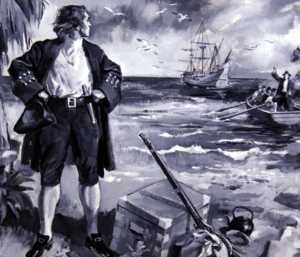
The HMS Bounty set sail from the coast of England with the intent to harvest breadfruit from the Pacific islands for cultivation in the West Indies in order to feed the slave labor during colonial times. The HMS Bounty was a Royal Naval vessel commissioned to Lieutenant William Bligh which experienced a mutiny of command headed by Fletcher Christian and a group of sailors. Bligh was associated with the Royal Navy since the age of 7 and was eventually trained by Captain James Cook before embarking on the maritime melee yet to unfold. Christian settled his men among the islands of Tahiti and Pitcairn before running the 90 foot, 215 ton Bounty aground and burning the ship to avoid detection from British authorities. Among many of the island spoils beheld by the mariners, skin ornamentation in the form of body tattoos was unique to Tahitian culture where it was worn equally by men and women. Since the British settlement of the island, tattooing became a ritual among servicemen and a widespread form of self-expression.
The Bounty left England en route to the South Pacific in 1789. After the mutiny, Bligh was left with no alternative than to navigate the ship’s launch together with a small group of loyalists and meager provisions toward the Dutch island of Timor near the northern Australian mainland. The distance covered well over 3,000 miles of open and treacherous sea, to which, Bligh proved himself worthy of captaincy. A matter of importance, considering the 23 foot launch was steered solely by quadrant, compass, sextant, and no navigation chart. A feat accomplished either through a method known as dead reckoning where a known fixed point drives the steering or through celestial navigation which relies on the Sun, Moon, or horizon for the reference point of travel. Bligh returned to England in 1790 to account for the reversal of fortune. An attempt to bring the majority of the mutineers to justice was met with tragic consequences when the HMS Pandora collided near the Great Barrier Reef and sank in the aftermath, prematurely curtailing the investigation effort. A sailor by the name of John Adams was the sole surviving member of the original Bounty entourage. The descendants of the mutineers remain on Pitcairn Island, to the present day.
The novel Mutiny on the Bounty was published in 1932 by Charles Nordhoff and James Norman Hall. This story inspired a second novel titled, Men Against the Sea, that was debuted in series by the 1933 Saturday Evening Post. It was followed by the final installment of the trilogy titled Pitcairn’s Island in 1934, also premiering in the Saturday Evening Post. A portion of the third novel is retold in the third person by Bounty crewman, John Adams. William Bligh died in 1817 with the title of Vice Admiral. However slight his passing may be construed, Bligh also served as Governor of New South Wales, a fledgling British colony at the time. That term of office in Australia, or New Holland under the Dutch crown, was subsequently derailed by the 1808 Rum Rebellion.
The insidiousness that transpired on the Bounty in the South Pacific was not the last in maritime history. It was followed by another occurrence on the Atlantic Ocean with a ship known as the Mary Celeste. The Mary Celeste was an American brigantine vessel crossing the Atlantic Ocean at the time it was discovered adrift, and unmanned. The Canadian brigantine Dei Gratia sighted the Mary Celeste on December 5, 1872 near the coastal waters of the Azores Islands, fully stocked with cargo and in seaworthy condition including many personal effects left undisturbed. The Mary Celeste was built and registered by the British in 1861, transferred to American ownership in 1868; wherein, it operated uneventfully until 1872. A shipwreck in the harbors of Haiti hastened its untimely demise in 1885. It is believed that the ship encountered a mutiny or Dei Gratia-led piracy on her New York to Genoa voyage of November 7, 1872. The remaining theories for her inexplicable abandonment have been revived in documentaries, novels, films, musicals, and plays. The ship’s name has grown to unabashedly symbolize crew desertion without compelling justification, regardless of the circumstances.
A maritime mystery along the Atlantic Ocean as harrowing as the jilted 1870s Mary Celeste occurred on July 19,1545. The British warship HMS Mary Rose was the navy flagship of King Henry VIII during Tudor sovereignty. It sank in the strait of Solent within sighting distance of the harbor in Portsmouth and the Isle of Wight. It appears to have become unstable as it was coming about toward starboard to fire canons during a skirmish against French navy vessels. Though there were survivors, King Henry actually witnessed the sinking from the vantage point of Southsea Castle while standing next to the captain’s wife, the true culprit perished with the vast majority of the sailors including the captain.
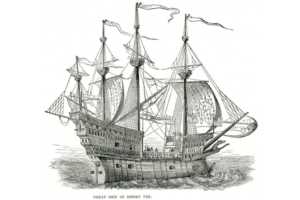
After being buried for nearly half a millennium at the seabed of the Solent, the resting point of Mary Rose was spotted in 1971. Thereafter, the Mary Rose Trust was organized in 1982 to return the royal warship back to port, this time to serve as a beacon of an era long since concluded. A bevy of scientists labored to preserve the historic remnant, as Prince Charles commandeered the Trust and participated in diving into the Solent to offer his support in the massive exhumation. As with the longstanding 1830s La Amistad dilemma, the Trust began the meticulous recording of crew and craft remains and reintroducing the salvage items to the public and to the royal establishment, centuries after the fact.
Many theories have been considered for the bewildering loss on the British side ranging from the captain, to the crew, to the shipwright, the king himself, to even an outright combination of all including the wind pattern and a mishandling of human and cargo weight aboard the impending wreck. As an ever-present reality of seafaring ways; the probability of a mutiny against Vice Admiral George Carew has never been fully discarded to the relief of any thorough inquiry into the puzzling demise of his command.
A 1962 Robert Hayden poem titled Middle Passage and a 2011 poem collection by Kevin Young titled Ardency have commemorated another equally perplexing uprising. Nearly 30 years before the abandonment of the Mary Celeste, a Spanish vessel carrying African slaves was the target of a rebellion at sea. The Mende slaves aboard La Amistad killed members of the crew and ordered the survivors to divert from the original destination back to the African coast. The Amistad intended to disembark the human cargo on plantations but was reoriented back in the direction of Long Island from its departure point of Cuba, in spite of the mutineer demands. The mutineers were subsequently remanded to Connecticut, then, set free against fervent claims of ownership by Spanish authorities. Only 35 of the original 53 captives were eventually resettled in Sierra Leone. A British governor greeted the Mende tribesmen aboard the SS Gentleman after completing the transatlantic voyage.
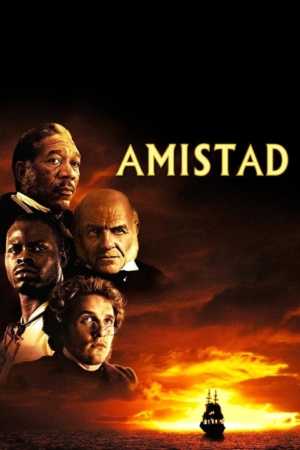
The Amistad was strictly a supply vessel and never operated for the sole purpose of slave transport though it did carry passengers, some of which were headed for the slave market. It steered clear of the infamous Middle Passage between the African continent and the Americas and, like the Mary Celeste, eventually became a symbol for an enduring social blight.
The enduring mythology, per se, set forth by the pen or by the lens is best conveyed by Mark Brokenshire in that “The test of a good adaptation is one which achieves repetition without replication, the adaptation both evokes and is amplified by a user’s experience of the original, while also taking on distinct qualities of its own. A successful adaptation balances ‘the comfort of ritual and recognition with the delight of surprise and novelty’, not only carrying the aura with it, but contributing to its continual expansion.” (The Chicago School of Media Theory)
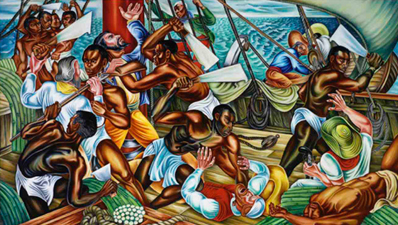
In all, the story of HMS Bounty notwithstanding the counterparts, would be retold in various forms but is primarily commemorated through five films. The earliest on record was a silent movie released in 1916 to Australian and New Zealand venues. Another 1933 Australian screening with Errol Flynn marked the actor’s debut and the transition from silent depiction to voice characterization. The first American version appeared in 1935 and remains the industry’s most touted achievement. That same year, the silver screen expanded to include the British portrayal of the ill-fated Mary Celeste. In 1962, the Bounty voyage was recast in 70mm film projection with an in-stereo sound score for another swath of the American audience. Then, the British produced their own account of events surrounding the Bounty in 1984, evoking a critical response as inconclusive as the actual mission itself. In the end: the Amistad, its charter, and the history-making that ensued was docked to celluloid in 1997 by American director Steven Spielberg, a move that would resonate to the tune of $44,229,441 US dollars. A princely sum or a king’s ransom by any standard. Most of these sea bound disasters are riddled with accusations of foul play, a consideration that cannot be marginalized. These waters have been host to numerous transgressions of sea piracy which have contributed to stately profits and legendary reputations when dismissed; tragic consequences of marooning, beheading, public hanging, flogging, and notoriety when confronted.
The early portion of the first millennium marks initial accounts of piracy in Asian waters during the Han Dynasty and later the Ming Dynasty. This activity surged on the north African coast by the Corsairs and in the Mediterranean by privateers. A volatile region claiming 500 ships, the Caribbean became renown for raids most notably by Sir Francis Drake who would make history as the first English privateer to circumnavigate the globe. At the height of this plunder, the Golden Age of Piracy is set into motion when the English and French begin terrorizing Spanish shipping lanes. The late 1700s in turn, bears the brunt of the storm as Caribbean piracy elevates to routine captures of unfathomable wealth against Indian trade territory.
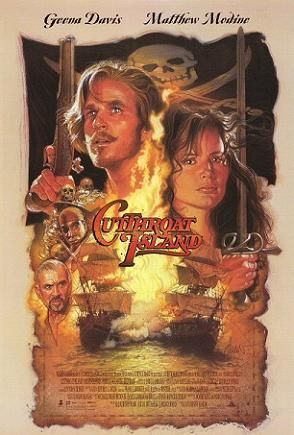
The death of Captain Blackbeard and Bartholomew Roberts and the capture of Captain Jack Rackham signal the end of the Golden Age in the early 1700s. The Rackham capture by the English brings to the fore the existence of two illusive female pirates, Anne Bonny and Mary Read. Their predominance would be challenged several decades later by an equally baffling Asian-borne piracy headed by female Captain Ching Shih and her battalion of 800 ships and 100,000 men. After the Golden Age of Piracy begins to subside about 1730, the period of 100 years following beheld the return of ex-privateers to the pirate frenzy and exacerbation of attacks on the Atlantic and Mediterranean. By 1850, piracy is outlawed in Central America and Asia; in other regions, it is scaled back through combined European and American military forces.
Any lingering doubt of incriminating nautical circumstances can be unearthed in modern day Africa. A civil war on the northeast coast of Africa spreads piracy into the Gulf of Aden after the Somali government dissolves. This adverse state of affair proliferates in the waters surrounding the Somali coast beginning in 1991, peaking in 2005 with incidents reported as recently as 2011. The point to all this: there may have been any number of veritable causes for the sinking or ransacking of ships past or present, yet isolating one in light of others fuels conjecture, one that has entertained legions of adventurous minds.
There is a long history of adapting “texts” into different forms. Historical events and spoken legends were the inspiration for paintings and sculptures, plays, written tales, stained glass windows, and later, stories in the form of the novel. Cinematic adaptations of literary and theatrical texts are as old as the medium of cinema itself, and as long as screen adaptations have existed, so has the tension between literature and film. Leo Tolstoy considered film “a direct attack on the methods of literary art”, while Virginia Woolf felt that cinema and literary adaptations in particular, were responsible for the moral decline and vulgarization of modern society, invoking the biological in her description of cinema as a “parasite” and literature as its “prey”. (Mark Brokenshire, The Chicago School of Media Theory)
Odd as it may seem, some sea journeys have taken on a life of their own irrespective of projection method and have become institutions in their own right. A journey unique in that regard is the self-proclaimed ‘successful failure’ of the SS Endurance headed by Sir Ernest H. Shackleton in 1914. This act of Antarctic exploration and extraordinary seamanship has been the subject of exhaustive examination by scholars in the essential realm of leadership cultivation. The crew of the Endurance set out to cross the South Pole in 1914 after departing from London. As one might expect, their ship became trapped between ice packs after leaving the port of South Georgia Island, a land settlement for whaling stations in the south Atlantic waterway. The vessel drifted astride the ice pack into the adjacent Elephant Island where Shackleton proposed a return trajectory to their initial docking in South Georgia in order to mount a rescue of the men marooned on Elephant Island.
The ship carpenter vehemently expressed concern over refitting the 22 foot lifeboat for the weather battering route back to South Georgia, a gesture that would have later repercussions. Through mere sailor instinct, the rescue party landed on the southern edge of the island, reaching the whaling station only after hiking across the desolate island terrain on foot. After some difficulty in reembarking to Elephant Island, Shackleton was eventually reunited with his men who had managed to persevere under a waning sentiment of recovery. The survival of all 28 crew members, despite the loss of the mother ship, was credited to the unnerving and unrelenting and unflinching charisma of Shackleton in the presence of devastating odds throughout the two year ordeal. In 1916, the majority of the sailors received medals of valor with the exception of the carpenter for what was overwhelmingly perceived as: a mutinous demeanor. Of the triumphant rescue, Shackleton contemplates the natural and preternatural forces that permeated their adventurous soul in his book, South: The Story of Shackleton’s Last Expedition 1914-1917.
When I look back at those days I have no doubt that Providence guided us, not only across those snowfields, but across the storm-white sea that separated Elephant Island from our landing-place on South Georgia. I know that during that long and racking march of thirty-six hours over the unnamed mountains and glaciers of South Georgia it seemed to me often that we were four, not three. I said nothing to my companions on the point, but afterwards Worsley said to me, ‘Boss, I had a curious feeling on the march that there was another person with us.’ Crean confessed to the same idea. One feels ‘the dearth of human words, the roughness of mortal speech’ in trying to describe things intangible, but a record of our journeys would be incomplete without a reference to a subject very near to our hearts.
These eventualities, its conspirators, and their corresponding progeny are vital in that they remind the audience of their own shortcomings while besetting a foundation for a subdued rather than an apathetic response to the intolerance of other people, remote places, and abhorrent events. A way to reorient the individual through greater consciousness over the matter at hand by relating to others bound by similar circumstances. In reliving the past or envisioning the future, these works can serve to empower both the leader and the follower in times of crisis or refrain and, in doing so, mitigate blind adherence to false, diminished, or misguided human destiny. Even if only for the brief span of a narrative sequence, the illusion of transformation within the staid semblance of existence and throughout the perpetual horizon, is well worth the time, the expense, and above all the effort to regale the art as archivist, thespian, critic, or reveler of dramatic pretense.

What do you think? Leave a comment.











I like the underlying theme of this article.
To be fair, fiction, and GOOD fiction, has rarely been close to realism.
Mutiny novels has been identified as one of the pieces of the mosaic in the construction of British identity.
I often forget that Steven Spielberg directed Amistad.
I appreciate any movie that is willing to take an honest look at American slavery (I.E. not sugar-coat it with some revisionist “Gone With The Wind” BS), and if you’re unfamiliar with the Amistad case, it’s an interesting time in history.
That being said, the middle passage scene is the most heart-wrenching, realistic depiction probably ever shot. You can really understand just how horrific the experience must’ve been.
I love this film. It is a testament to the indomitable spirit of human freedom.
There are some flaws in it but it’s a powerful film with an interesting story that was certainly worth telling.
I think India, and any other country, is better for having had the Brits there than not. As an interesting alternative, I think the French had lovely colonies, and I find nationalists and independence freaks everywhere to be quite boring, flat navel-gazers who can’t tell Proust from Dan Brown.
A year ago I read ‘Plain Tales from the Raj’, the book form of a Radio 4 series from the early 1970s. It features the experiences of the British men and women who lived and worked in India during the Raj.
The book tries not to be ‘political’ but it is interesting. Not least because you can still see the colonial life in middle class Pakistan now. You can still see the love of children and the willingness to help out.
At the same time, it makes pretty clear that the British in India knew full well what they were doing. In their own words, they subjugated and exploited a people. They didn’t leave a developed, prosperous country.
Whilst many sought to serve India, by doing their best as they saw it, they also knew full well the racial, class and religious divides they had set up; not only amongst the Indians but amongst themselves.
Necessarily it’s about the British and how they see and relate to colonial India, with very little about the Indians themselves. But it does tell you (strangely) a lot about modern India and Pakistan.
It is not black and white, with set political positions. And I (as a staunch anti colonialist and republican) would say it challenges the assumptions of many people interpreting the Raj who (because of the passage of time) have no direct experience of it; both Right and Left.
Interesting. Do you think Ireland is better for having/having had the Brits in control?
Lovely piece.
I love the fascinating diversities of mutiny fiction, as well as the politics of representation.
The adaptions are emulating fiction more than adapting the stories of mutiny.
If I wanted to and had the time, I could dismantle every historical film ever made.
Great history lesson, even better film study.
It is interesting how mutiny oriented novels were a highly popular literary genre in the nineteenth century.
Surely Admiral Nelson’s victory against the French near Gibraltar helped in romanticizing this.
Nice work on this topic. It reflects the anxieties of the age.
Good to see this article go live and to judge by the response, well done! Plenty of opinions being expressed. One comment though – is there an image missing after the sentence ‘That term of office in Australia, or New Holland under the Dutch crown, was subsequently derailed by the 1808 Rum Rebellion’? All I see is a blank patch on the ‘map’ of your page or is that an uncharted territory?
Amyus–Thanks for the remarks. It’s probably just a glitch. But, just in case, that blank patch should be a link to a sound recording on the Mary Celeste. I am providing a copy for the benefit of all readers below. I wanted to provide imagery from all angles for all palettes, enjoy–Luis
https://soundcloud.com/abc_rn/preview-a-thoroughly-wet-mess-the-story-of-the-mary-celeste
Hi Luis, thanks for the missing link. A most interesting story indeed.
Strong and intellectual article.
Well said!
A great read. A thoroughly interesting topic reported in an engaging manner. It was great to see the inclusion of further informative video exerts, which I don’t often see on the site, but was a wonderful way to provide some visual representations of such a topic. Great work!
A interesting topic and the way it is portrayed is awesome.
I really liked this it was interesting. I think an interesting follow-up to this would be a similar article on piracy comparing real piracy to its depiction in film and television.
A good essay.